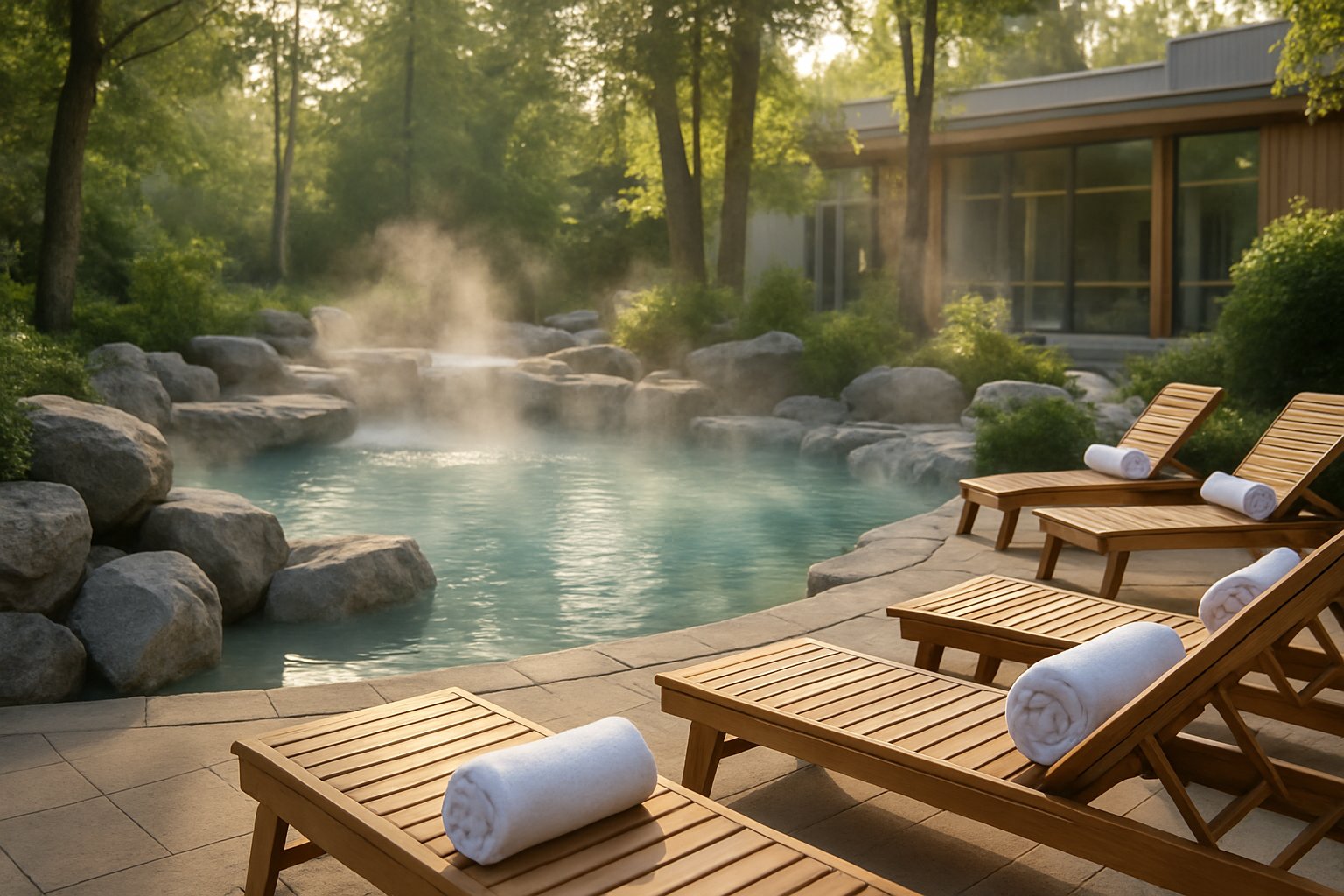Thermal Spas: A Pathway to Wellness, Relaxation & Rituals
A thermal spa offers a wellness experience centred on alternating between hot and cold water treatments (also called contrast therapy), combined with periods of rest to promote deep relaxation and health benefits. These unique facilities feature heated pools, saunas, steam rooms, and cold plunges that work together to create a therapeutic cycle for both body and mind.
The thermal experience is a wellness ritual based on ancient traditions that have been practiced for centuries across different cultures. Modern thermal spas like Nature’s Elements Wellness combine these time-tested methods with contemporary amenities like massage treatments, specialized facilities, and relaxation areas. Visitors can expect to move through various temperature zones at their own pace while experiencing the rejuvenating effects of this natural healing process.
Understanding what to expect from a thermal spa visit helps maximize the wellness benefits and ensures a more enjoyable experience. From the core elements that make up the thermal journey to planning considerations for first-time visitors, thermal spas offer a structured yet flexible approach to relaxation that differs significantly from traditional day spas or wellness centres.
What Is a Thermal Spa?
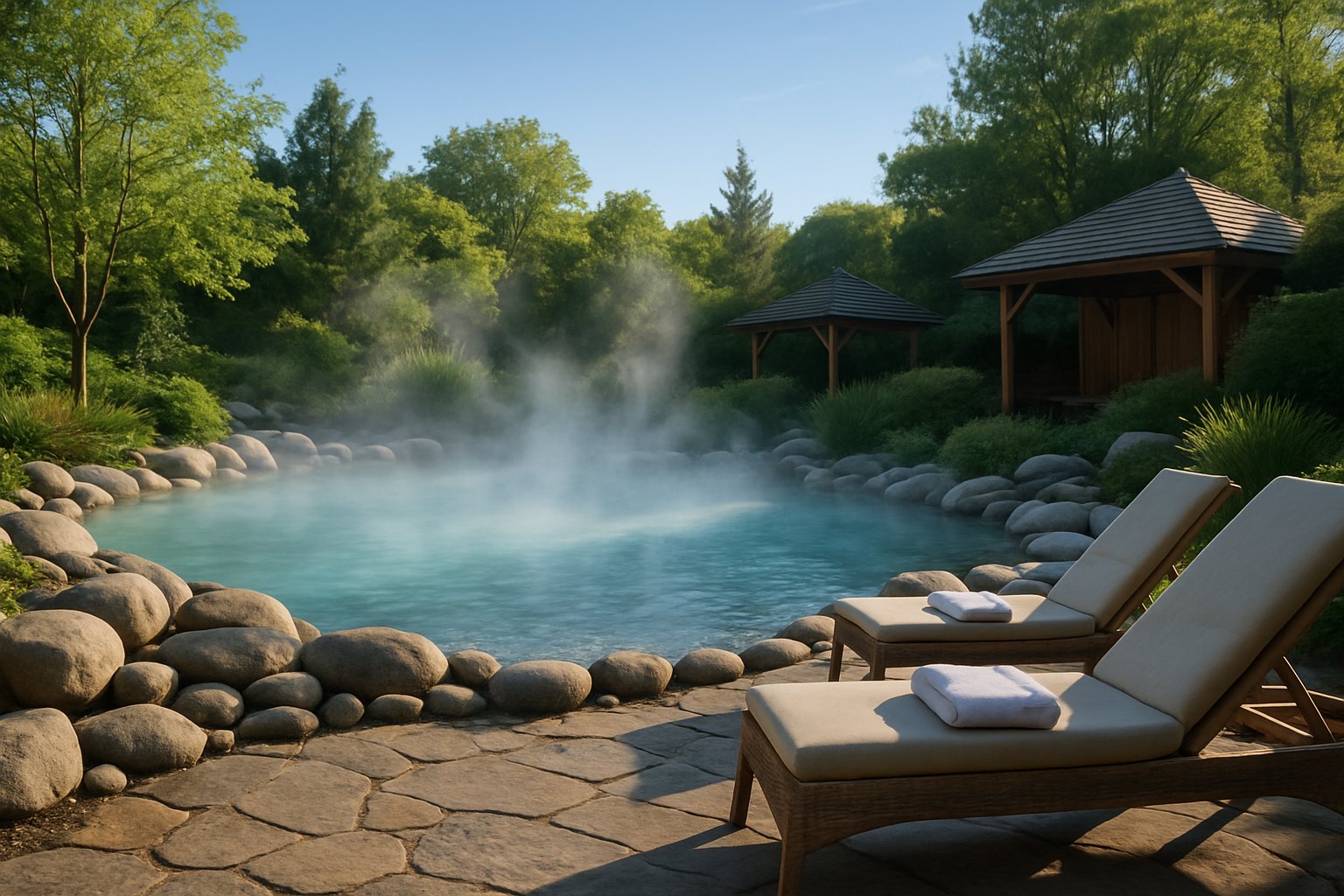
A thermal spa uses naturally heated mineral water and various temperature treatments to promote health and relaxation. These facilities combine ancient healing traditions with modern wellness concepts to create therapeutic experiences through controlled heat and cooling cycles.
History of Thermal Spa Tradition
Thermal spa treatments date back thousands of years to ancient civilizations. Romans built elaborate bathhouses around natural hot springs, recognizing the healing properties of mineral-rich waters.
Ancient Greeks used thermal baths for both medical treatment and social gatherings. They believed the mineral content in heated water could cure various ailments and improve overall health.
Throughout history, people visited thermal springs to treat joint pain, skin conditions, and respiratory problems. European cultures developed sophisticated thermal bath cultures, with entire towns built around natural hot springs.
The tradition continued through medieval times when thermal baths were prescribed by physicians. Monasteries often maintained thermal facilities, combining spiritual practices with physical healing.
Modern thermal spa culture emerged in the 18th and 19th centuries. Wealthy Europeans traveled to thermal resort towns for extended healing retreats, establishing the foundation for today’s spa industry.
How Thermal Spas Work
Thermal spas use mineral-medicinal waters that contain therapeutic properties from underground sources. These waters must be at least 4°C warmer than the average yearly temperature of surrounding water sources.
The mineral content varies by location but typically includes sulfur, calcium, magnesium, and sodium. Each mineral provides specific therapeutic benefits for different health conditions.
Temperature changes open pores and encourage perspiration, which helps remove toxins from the body. The process stimulates blood circulation and can boost immune system function.
Visitors move between different temperature stations in a specific sequence. Hot treatments include saunas, steam rooms, and heated mineral pools. Cold treatments involve ice rooms, cold plunge pools, or cool showers.
The contrast between hot and cold temperatures creates a therapeutic cycle. This process can help reduce stress, improve circulation, and provide relief from muscle tension and joint stiffness.
Modern Thermal Spa Concepts
Contemporary thermal facilities offer comprehensive wellness experiences beyond traditional bathing. Modern thermal spas combine multiple heat-based treatments with additional services like massage and skincare.
A spa village concept integrates thermal experiences with dining, accommodation, and recreational activities. These destinations provide multi-day wellness retreats rather than single-visit treatments.
Thermal experiences include access to multiple saunas, outdoor baths, indoor and outdoor rest areas, and restaurants. Facilities design specific pathways to guide visitors through optimal temperature sequences.
Modern thermal suites feature innovative technology like infrared saunas, salt therapy rooms, and aromatherapy steam chambers. These additions enhance traditional thermal benefits with targeted therapeutic approaches.
Many facilities now offer educational components, teaching visitors proper thermal suite etiquette and optimal usage patterns. Staff members guide newcomers through the experience to maximize health benefits and ensure safety.
Core Elements of the Thermal Spa Experience
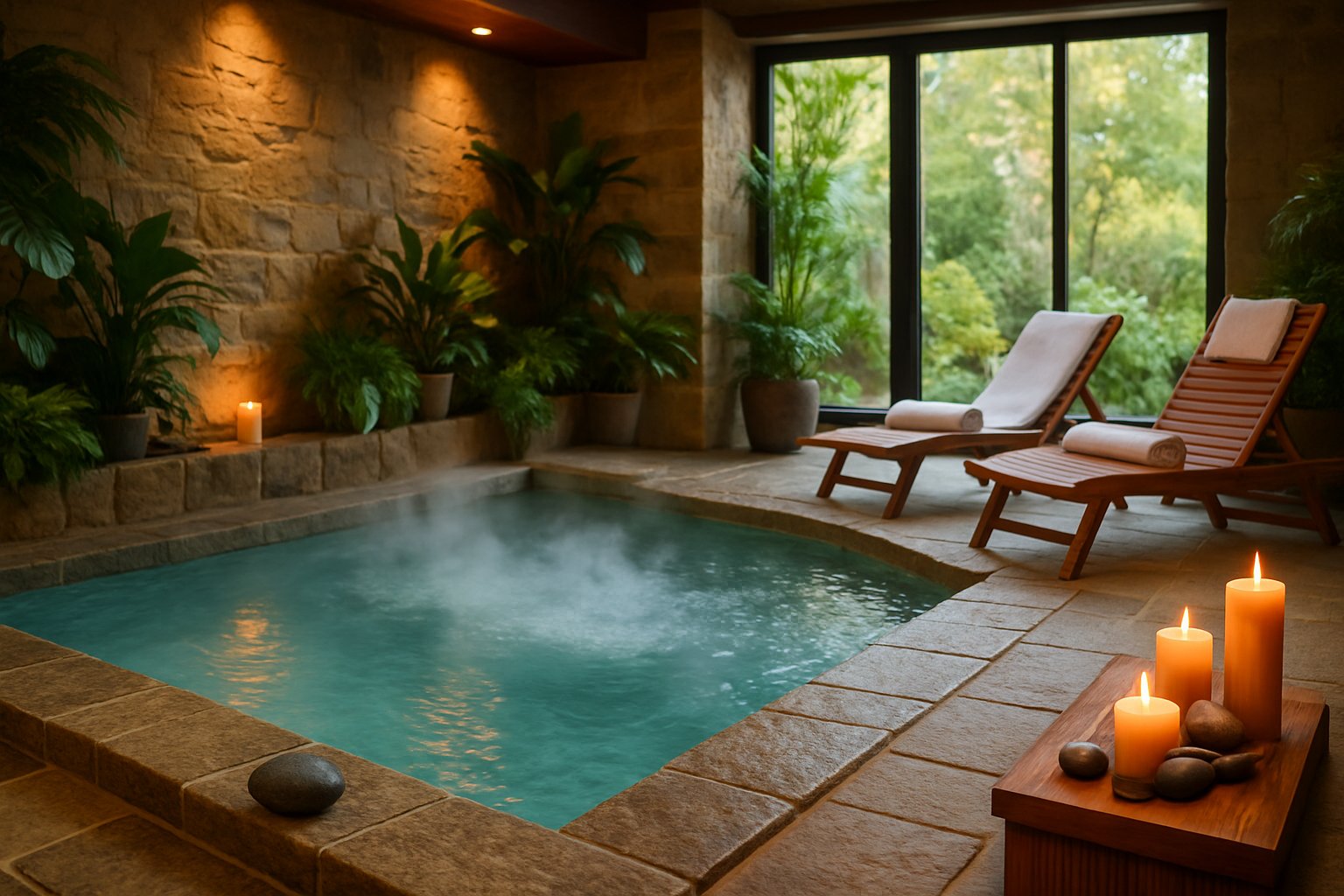
The thermal spa experience centers on three fundamental phases: heat exposure, cold therapy, and rest periods. These elements work together through specific facilities including saunas, steam rooms, thermal baths, cold plunges, and dedicated relaxation spaces.
Thermal Journey Explained
The thermal cycle follows three distinct phases that create physiological responses in the body. This ancient practice has been used for over 2000 years across different cultures.
Phase 1: Heat (10-15 minutes)
- Body temperature rises
- Blood vessels dilate
- Immune system activates
- Toxins flush out through sweat
- Muscle tension releases
Phase 2: Cold (10-15 seconds)
- Thermal shock triggers adrenaline release
- Blood circulation improves rapidly
- Pores tighten
- Skin feels refreshed and invigorated
Phase 3: Rest (minimum 20 minutes)
- Body recovers and stabilizes
- Endorphins release naturally
- Deep relaxation occurs
- Heart rate normalizes
The alternating hot and cold phases create maximum benefits when proper timing is followed. Each phase allows the body to fully absorb the therapeutic effects.
Saunas and Steam Rooms
Saunas provide dry heat typically ranging from 160-200°F with low humidity levels. Traditional saunas use heated stones or electric heaters to create this environment.
Steam rooms operate at lower temperatures around 110-120°F but with nearly 100% humidity. The moist heat feels less intense but penetrates deeper into the skin.
Key differences include:
| Feature | Sauna | Steam Room |
|---|---|---|
| Temperature | 160-200°F | 110-120°F |
| Humidity | 5-30% | 95-100% |
| Heat Type | Dry | Moist |
| Materials | Wood | Tile/Stone |
Higher seating positions in saunas provide more intense heat exposure. The body responds by increasing circulation and activating sweat production within minutes.
Thermal Baths and Pools
Thermal baths feature water heated to specific temperatures for therapeutic purposes. Most facilities maintain pools between 98-104°F for optimal comfort and benefits.
Hot pools help muscles relax and joints loosen. The buoyancy reduces pressure on the body while heat penetrates deep into tissues.
Mineral-enriched thermal waters provide additional therapeutic properties. Common minerals include sulfur, magnesium, and calcium which absorb through the skin.
Pool temperatures vary by purpose:
- Warm pools: 98-100°F for gentle therapy
- Hot pools: 101-104°F for muscle relief
- Therapeutic pools: 105-108°F for intensive treatment
Different pool designs serve specific functions from shallow soaking areas to deeper movement pools for gentle exercise.
Cold Plunge and Rest Areas
Cold plunge pools maintain temperatures between 50-60°F to create the thermal shock needed for circulation benefits. Some facilities offer ice baths as cold as 35-40°F for more intense therapy.
The brief cold exposure should last only 10-15 seconds for beginners. More experienced users may extend to 30-60 seconds safely.
Rest areas provide comfortable spaces for the final phase of the thermal journey. These include:
- Heated relaxation loungers
- Quiet meditation spaces
- Fire pits and warming areas
- Hammocks and outdoor seating
Proper rest areas maintain comfortable ambient temperatures around 70-75°F. The environment should promote deep relaxation without distractions.
The rest phase produces endorphins that create feelings of calm and well-being. This final step completes the thermal cycle and maximizes the therapeutic benefits.
Wellness and Relaxation Benefits
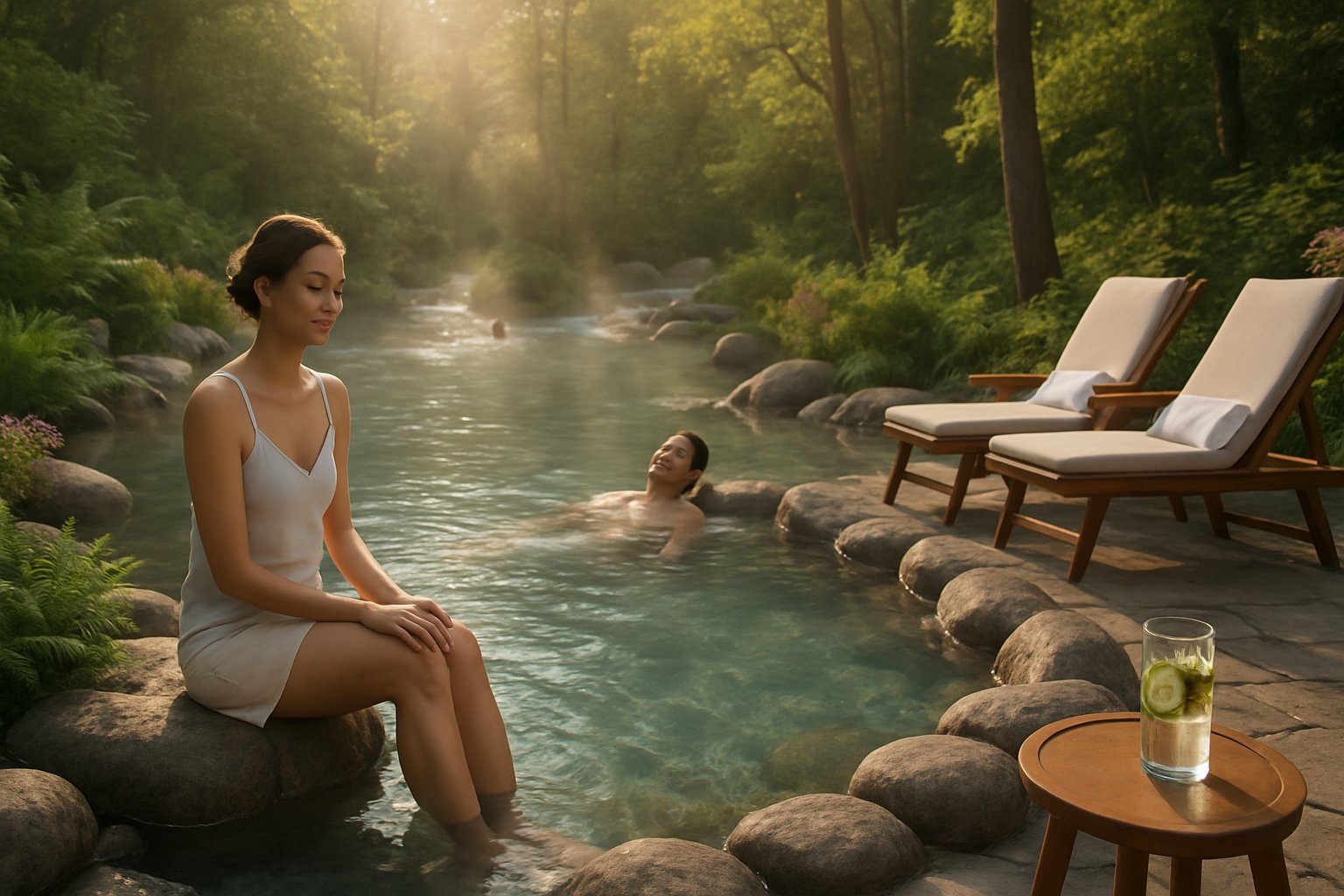
Thermal spa treatments deliver measurable improvements to physical health through enhanced circulation and muscle recovery. These therapeutic experiences reduce stress hormones by up to 58% while strengthening immune system function through controlled temperature exposure.
Physical Health Improvements
Thermal therapy accelerates muscle recovery through improved blood flow and oxygen delivery. The alternating hot and cold treatments cause blood vessels to expand and contract, pushing nutrients to damaged tissues faster.
Heat treatments reaching 90 degrees Celsius help flush toxins from the body through increased perspiration. This process cleanses pores and removes impurities that can cause skin problems.
The temperature changes boost metabolism by forcing the body to work harder to regulate its core temperature. This increased metabolic rate continues for hours after treatment ends.
Regular thermal spa visits can reduce muscle soreness by 40% compared to passive recovery methods. Athletes often use these treatments to speed healing between training sessions.
Hydrotherapy pools with multiple jets target specific muscle groups to release tension. The combination of heat and massage reduces inflammation in joints and soft tissues.
Mental Wellness & Stress Reduction
Thermal environments trigger the release of endorphins, serotonin, and dopamine in the brain. These natural chemicals create feelings of calm and happiness that last long after treatment.
Studies show that mindfulness practices in thermal spas reduce anxiety symptoms by 58%. The quiet, phone-free environment allows complete mental disconnection from daily stressors.
Heat exposure lowers cortisol production, the hormone responsible for stress responses. Lower cortisol levels improve sleep quality and reduce the risk of stress-related health problems.
The forced digital detox during thermal treatments helps reset mental focus. Without electronic distractions, visitors can practice meditation and deep breathing techniques more effectively.
Regular thermal spa visits improve sleep patterns by regulating the body’s natural temperature cycles. Better sleep leads to improved mood and cognitive function during waking hours.
Boosting Immunity and Circulation
Thermal treatments strengthen the immune system by creating controlled stress responses. The body adapts to temperature changes by producing more white blood cells and antibodies.
Cold plunges following heat exposure stimulate the lymphatic system. This drainage network removes waste products and toxins from tissues throughout the body.
Enhanced circulation delivers immune cells to all body areas more efficiently. Better blood flow helps the body identify and fight infections before they spread.
The thermal cycle alternating hot and cold exposure trains blood vessels to respond quickly to temperature changes. This flexibility improves cardiovascular health over time.
Ice fountains and cold showers cause temporary vasoconstriction followed by rapid dilation. This process exercises the cardiovascular system and strengthens heart function.
Regular thermal therapy users report 30% fewer sick days compared to those using traditional relaxation methods. The immune system benefits accumulate with consistent treatment schedules.
Signature Treatments & Facilities
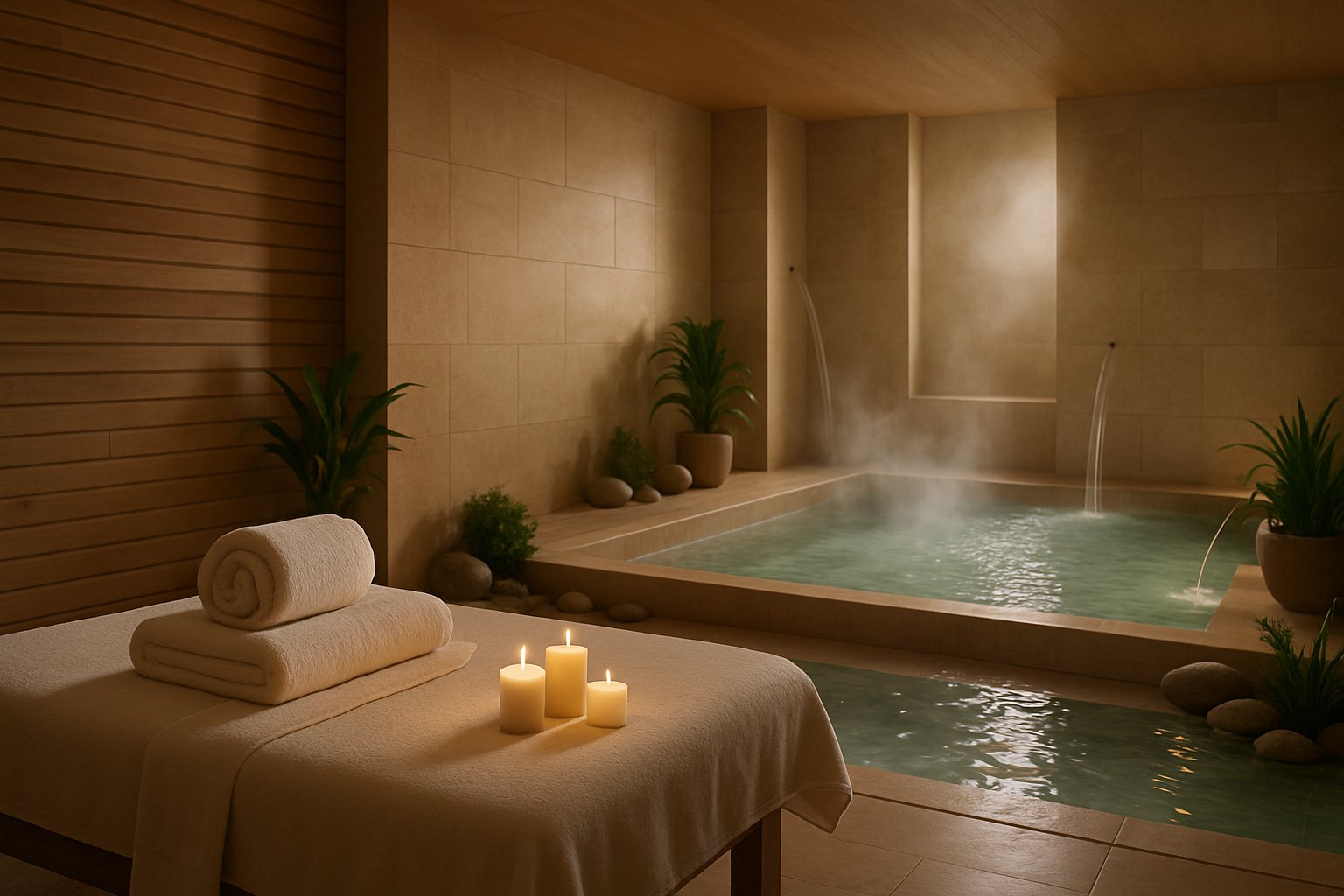
Thermal spas distinguish themselves through specialized massage treatments that incorporate heated elements and unique rituals centered around mineral-rich thermal waters. These facilities feature both private treatment rooms and communal relaxation areas designed to maximize the therapeutic benefits of natural thermal springs.
Massage Treatments
Thermal spa massage treatments integrate heated stones, warm oils, and therapeutic techniques tailored to each guest’s needs. Hot stone massage therapy combines smooth basalt stones with traditional massage methods to promote deep muscle relaxation.
Deep tissue massage targets specific muscle groups and pressure points. Treatment durations typically range from 25 to 85 minutes, with pricing varying based on session length and technique complexity.
Prenatal massage accommodates expecting mothers during their second and third trimesters. These specialized sessions use modified positioning and gentle pressure techniques to ensure safety and comfort.
Reflexology focuses on pressure points in the feet to stimulate healing throughout the body. Scalp massage treatments concentrate on the upper body, targeting the head, neck, and shoulder areas for stress relief and tension reduction.
Many thermal spas offer enhancement options including aromatic oil blends and specialized hydrating treatments. These additions complement the base massage service without extending the treatment duration.
Unique Spa Rituals
Thermal spa rituals incorporate mineral-rich waters and natural elements into comprehensive wellness experiences. Hydrotherapy treatments utilize heated water jets to massage muscles and joints while increasing blood circulation to damaged tissue.
Body wraps begin with exfoliation using sugar and salt scrubs, followed by nourishing treatments featuring organic ingredients like shea butter and coconut oil. These rituals often conclude with moisturizing applications to restore skin hydration.
Couples treatments allow partners to experience services simultaneously in dedicated rooms. These packages typically include wine service and food amenities alongside the spa treatments.
LED light therapy combines traditional facials with red light and near-infrared technology to stimulate collagen production. Blue light treatments target acne-causing bacteria for purifying effects on problematic skin.
Specialized body treatments feature aromatic blends and probiotic ingredients designed to rejuvenate skin from head to toe. Treatment packages often combine multiple services for comprehensive wellness experiences.
Private and Communal Lounges
Thermal spa facilities feature dedicated lounge areas for relaxation before and after treatments. Private treatment rooms ensure guest privacy during individual services, while communal spaces encourage social relaxation.
Indoor amenities include Himalayan salt saunas, heated pools, and comfortable seating areas. Outdoor facilities typically feature multiple thermal pools maintained at varying temperatures and Finnish-style sauna cabins.
Oasis day passes provide access to thermal facilities without requiring spa appointments. These passes cost approximately $60 for standalone access or $35 as treatment add-ons.
Group booking areas accommodate parties of six or more guests with reserved spaces for food and beverage service. These areas require minimum seven-day advance reservations and include shareable platters and wine options.
Lounge facilities extend treatment benefits by allowing guests to continue relaxation in comfortable environments. Many spas provide refreshments and quiet spaces designed to maintain the therapeutic atmosphere throughout the visit.
How to Plan Your Visit to a Thermal Spa
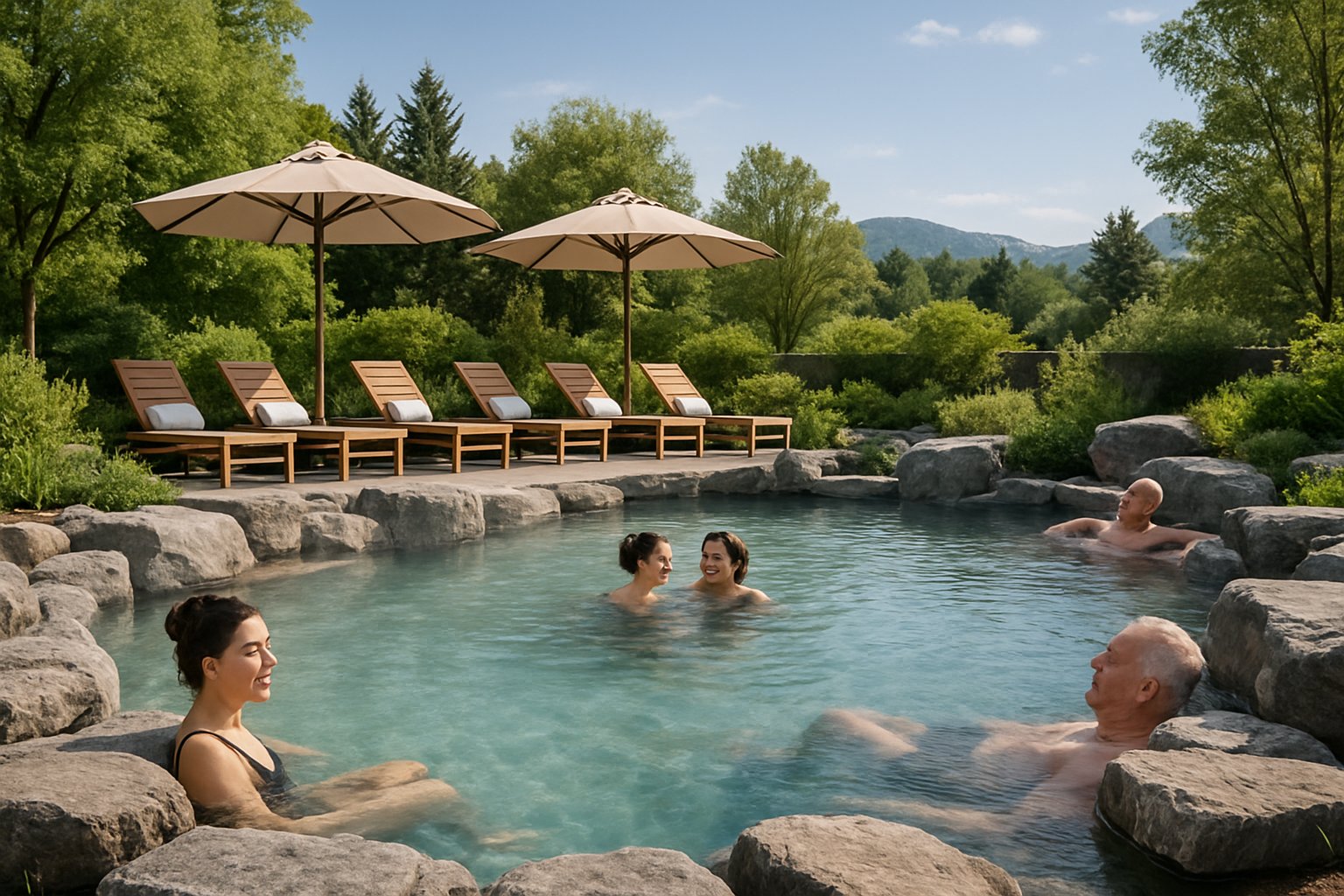
Success at a thermal spa depends on selecting the right facility and understanding proper preparation. Most visitors benefit from learning basic etiquette and timing their visit during off-peak hours.
Choosing the Right Spa Village
Different spa villages offer unique features and experiences. Some focus on traditional treatments while others emphasize modern amenities.
Research facilities that match your comfort level. First-time visitors often prefer smaller spas with clear signage and helpful staff. More experienced guests might enjoy larger complexes with diverse thermal options.
Check what’s included in admission fees. Many spas provide towels, robes, and basic amenities. Others charge extra for these items.
Look for facilities with thermal cycle guidance posted throughout the property. This helps newcomers understand the proper sequence of hot, cold, and rest phases.
Consider seasonal factors when booking. Winter visits offer unique experiences like outdoor hot pools surrounded by snow. Summer visits provide longer outdoor relaxation periods.
Preparing for Your Thermal Experience
Pack essential items for your thermal experience. Bring a swimsuit and flip-flops as your primary requirements.
Most spas don’t guarantee swimwear availability in all sizes. Water shoes help navigate wet surfaces safely between different thermal areas.
Bring a refillable water bottle to stay hydrated. The thermal cycle causes significant fluid loss through perspiration. Dehydration can occur quickly in hot saunas and steam rooms.
Avoid eating large meals before your visit. Light snacks 2-3 hours prior work best for comfort during temperature changes.
Don’t drink alcohol before or during your thermal experience. This reduces the health benefits and can cause dangerous reactions to extreme temperatures.
Plan for 2-3 hours minimum for a complete thermal cycle. This allows time to repeat the hot-cold-rest sequence multiple times for maximum benefit.
Etiquette and Tips for Visitors
Shower before entering any thermal facility. This basic hygiene rule applies to all hot tubs, saunas, and steam rooms.
Wear your swimsuit at all times in thermal areas. Dry off completely before entering relaxation lounges and reception areas.
Keep noise levels low throughout the facility. The thermal experience focuses on relaxation and mental reset for all guests.
Leave phones in lockers during your visit. This enhances your relaxation and respects others seeking quiet time.
Book massages to maximize value. Many facilities offer free spa access with massage appointments, making treatments more affordable.
Visit during off-peak times for better experiences. Weekday evenings and early mornings typically have fewer crowds and more peaceful environments.
Tip massage therapists appropriately, especially if using insurance coverage for treatments. Standard rates apply regardless of payment method.
Frequently Asked Questions
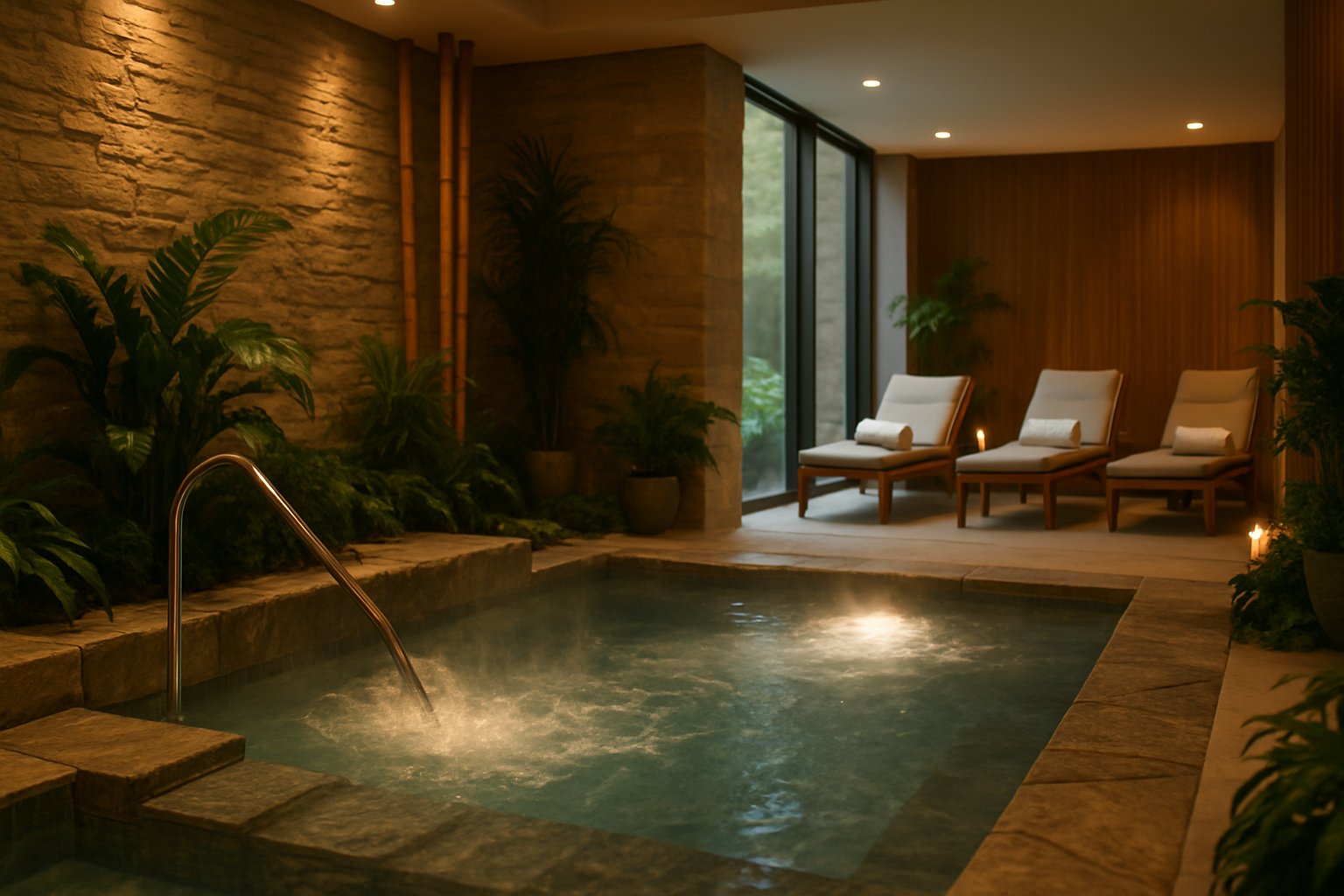
Thermal spa visitors commonly ask about health benefits, skin condition improvements, and treatment frequencies. Understanding safety considerations, first-visit expectations, and available treatment types helps people make informed decisions about thermal spa experiences.
What are the health benefits associated with visiting a thermal spa?
Thermal spa treatments provide multiple therapeutic benefits through mineral-rich heated water exposure. The warm water improves blood circulation, reduces muscle tension, and promotes joint mobility.
Regular thermal spa visits can help decrease stress levels and improve sleep quality. The heat from thermal waters relaxes the nervous system and encourages the release of endorphins.
Thermal mineral waters often contain beneficial elements like sulfur, magnesium, and calcium. These minerals can be absorbed through the skin during soaking sessions.
The buoyancy of thermal water reduces pressure on joints and muscles. This makes thermal spas particularly beneficial for people with arthritis or chronic pain conditions.
Can thermal spa treatments help with specific skin conditions?
Thermal waters containing sulfur compounds can help improve certain skin conditions like eczema and psoriasis. The minerals in thermal springs have anti-inflammatory properties that may soothe irritated skin.
Some thermal spas offer treatments specifically designed for skin health. These treatments combine mineral-rich water with therapeutic mud or algae applications.
People with sensitive skin should consult healthcare providers before thermal spa visits. Certain mineral concentrations or water temperatures might cause skin reactions in some individuals.
The exfoliating properties of thermal water can help remove dead skin cells. This natural process may improve skin texture and appearance over time.
What should one expect during their first visit to a thermal spa?
First-time thermal spa visitors typically receive orientation information about facility rules and safety guidelines. Most spas require advance reservations and provide towels, robes, and lockers for guest use.
Initial visits usually begin with lower temperature pools before progressing to hotter thermal baths. This gradual approach helps the body adjust to different water temperatures safely.
Spa staff often recommend alternating between hot and cold water treatments. This contrast therapy can enhance circulation benefits and provide a more complete thermal experience.
Many thermal spas have quiet zones where conversation is limited or prohibited. Understanding facility etiquette helps ensure a peaceful environment for all visitors.
Are there any medical conditions that could be exacerbated by thermal spa treatments?
People with heart conditions, high blood pressure, or circulation problems should consult physicians before thermal spa visits. Hot water exposure can affect cardiovascular function and blood pressure levels.
Pregnant women face specific restrictions at thermal spas, particularly regarding water temperature limits. Most facilities recommend avoiding baths over 37°C during pregnancy and prohibit sauna use entirely.
Individuals with open wounds, infections, or contagious skin conditions should postpone thermal spa visits. These conditions can worsen in warm, moist environments or spread to other guests.
People taking medications that affect temperature regulation or blood pressure need medical clearance. Some prescription drugs can alter the body’s response to heat exposure.
How often should one visit a thermal spa to experience its benefits?
Regular thermal spa visits provide cumulative health benefits compared to occasional treatments. Weekly or bi-weekly sessions often produce more noticeable improvements in stress reduction and muscle tension relief.
People using thermal spas for specific health conditions may need more frequent visits initially. Chronic pain or skin condition management might require several sessions per month.
Individual tolerance levels and health goals determine optimal visit frequency. Some people benefit from monthly relaxation sessions while others prefer weekly therapeutic treatments.
Budget considerations and travel distance often influence visit frequency practically. Most thermal spa benefits can be maintained with visits ranging from weekly to monthly intervals.
What types of thermal spa treatments are available and how do they differ?
Thermal pools represent the most common treatment type, featuring mineral-rich water heated to various temperatures. These pools typically range from lukewarm soaking areas to hot therapeutic baths.
Thermal mud treatments combine heated mineral-rich mud with spa water for skin and joint benefits. The mud application process involves covering specific body areas or full-body wraps followed by thermal water rinsing.
Steam rooms and saunas use thermal heat without water immersion to promote sweating and relaxation. These dry heat treatments often complement water-based thermal therapies during spa visits.
Contrast therapy alternates between hot thermal baths and cold plunge pools or showers. This temperature variation stimulates circulation and may enhance the therapeutic effects of thermal treatments.
Scandinavian Style Thermal Spa in Ontario

